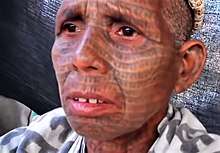Ramnami Samaj
The Ramnami Samaj is a Hindu sect founded by Parasuram in the 1890s that worships the god Ram. Living mainly in Chhattisgarh, its adherents tattoo the word "Ram" on their bodies and wear shawls with the word "Ram" printed on it and headgear made of peacock feathers. Estimates of the group's population range from about 20,000 to more than 100,000.

History
Parasuram (or Parashu Ram Bhardwaj), born in the 1870s in Charpora village according to anecdotal accounts, is believed to be the first person to tattoo the word "Ram" on his forehead[1] in the 1890s and is considered to be the sect's founder.[2] Parasuram tattooed himself as an act of defiance after being denied entry to a temple because of his caste; according to one follower in 2017 the tattoos say "Who needs a temple when we have the name of god written on us? God is everywhere and not just in temples."[2] According to Ramdas Lamb, the sect is a continuation of the 15th century Bhakti movement[1] and an offshoot of the region's Satnampanth.[3]
In 1910, the Ramnamis won a court case against upper caste Hindus over the right to use the name of the god Ram.[4] As late as the 1980s tattooed followers were denied entrance to temples because their tattoos "gave away their caste."[2]
Practices
The sect's adherents do not drink or smoke, chant the name of Ram everyday,[5] tattoo the word "Ram" on their body, and wear a shawl with the word "Ram" printed on it and a headgear made of peacock feathers. Those with full body tattoos are knows as "purnanakshik" and are mostly in their seventies; the younger generations of Ramnamis are no longer tattooed, fearing that they might be discriminated against and denied work because of the tattoos.[1] Ramnamis gather every year for a three-day Bhajan Mela at the end of the harvest season in December–January in the village of Sarsiwa in Raipur district where they erect a jayostambh (a white pillar with the name of Ram inscribed on it) and chant from the Ramcharitmanas.[1]
Demographics
Since Ramnamis are listed simply as Hindus in official records, accurate demographic data is unavailable but elders estimate their population to be no more than 20,000 based on the attendance at the annual Bhajan Mela;[1] although others estimate it to be more than 100,000.[5] Ramnamis live primarily in villages along the Mahanadi river in Chhattisgarh, but some adherents also live in border regions of Maharashtra and Odisha.[1]
References
Notes
Sources
- Abidi, Adnan (14 January 2016). "Tattoos, faith and caste". Reuters. Archived from the original on 21 November 2017. Retrieved 13 April 2020.
- Dam, Abhirup (22 November 2019). "In search of Ram: The death of wisdom, tradition and philosophy". The Telegraph. Archived from the original on 23 November 2019. Retrieved 13 April 2020.
- Kohli, Namita (14 May 2016). "The God of Small Things: The last few with Ram inked on their bodies". Hindustan Times. Archived from the original on 27 July 2017. Retrieved 13 April 2020.
- Lamb, Ramdas (29 August 2002). Rapt in the Name: The Ramnamis, Ramnam, and Untouchable Religion in Central India. SUNY Press. ISBN 0791453855.
- Mitra, Joydip (30 November 2017). "In the name of Ram". People's Archive of Rural India. Archived from the original on 3 October 2019. Retrieved 12 April 2020.
- Shafi, Showkat (16 January 2017). "In the name of Ram: Tattoos in India's Dalit community". Al-Jazeera. Archived from the original on 9 November 2018. Retrieved 12 April 2020.